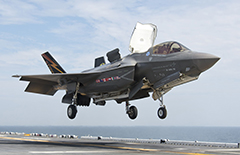Vertical Takeoff and Landing (VTOL)
A vertical take-off and landing (VTOL) aircraft is one that can hover, take off, and land vertically. This classification can include a variety of types of aircraft including fixed-wing aircraft as well as helicopters and other aircraft with powered rotors, such as cyclogyros/cyclocopters and tiltrotors. Some VTOL aircraft can operate in other modes as well, such as CTOL (conventional take-off and landing), STOL (short take-off and landing), and/or STOVL (short take-off and vertical landing). Others, such as some helicopters, can only operate by VTOL, due to the aircraft lacking landing gear that can handle horizontal motion. VTOL is a subset of V/STOL (vertical and/or short take-off and landing). Some Lighter Than Air aircraft also qualify as VTOL aircraft, as they can hover, takeoff, and land with vertical approach/departure profiles.
 Besides the ubiquitous helicopter, there are currently two types of VTOL aircraft in military service: craft using a tiltrotor, such as the Bell Boeing V-22 Osprey, and another using directed jet thrust, such as the Harrier family and new F-35B Lightning II Joint strike Fighter (JSF). In the civilian sector currently only helicopters are in general use (some other types of commercial VTOL aircraft have been proposed and are under development as of 2017). Generally speaking, VTOL aircraft capable of STOVL use it wherever possible, since it typically significantly increases takeoff weight, range or payload compared to pure VTOL.
Besides the ubiquitous helicopter, there are currently two types of VTOL aircraft in military service: craft using a tiltrotor, such as the Bell Boeing V-22 Osprey, and another using directed jet thrust, such as the Harrier family and new F-35B Lightning II Joint strike Fighter (JSF). In the civilian sector currently only helicopters are in general use (some other types of commercial VTOL aircraft have been proposed and are under development as of 2017). Generally speaking, VTOL aircraft capable of STOVL use it wherever possible, since it typically significantly increases takeoff weight, range or payload compared to pure VTOL.
The Harrier is usually flown in STOVL mode, which enables it to carry a higher fuel or weapon load over a given distance. In V/STOL the VTOL aircraft moves horizontally along the runway before taking off using vertical thrust. This gives aerodynamic lift as well as thrust lift and permits taking off with heavier loads and is more efficient. When landing the aircraft is much lighter due to the loss of propellant weight and a controlled vertical landing is possible.
Now retired from British Royal Navy service, the Indian Navy operates Sea Harriers mainly from its aircraft carrier INS Viraat. The latest version of the Harrier, the BAE Harrier II has also been retired in December 2010, after being operated by the British Royal Air Force and Royal Navy. The United States Marine Corps, and the Italian and Spanish Navies use the AV-8B Harrier II, an equivalent derivative of the Harrier II. The Harrier II/AV-8 will be replaced in the air arms of the US and UK by a STOVL variant of the Lockheed Martin F-35 Lightning II. An important aspect of Harrier STOL operations aboard Naval carriers was the "ski jump" raised forward deck, which gave the craft additional vertical momentum at takeoff. More details
 Besides the ubiquitous helicopter, there are currently two types of VTOL aircraft in military service: craft using a tiltrotor, such as the Bell Boeing V-22 Osprey, and another using directed jet thrust, such as the Harrier family and new F-35B Lightning II Joint strike Fighter (JSF). In the civilian sector currently only helicopters are in general use (some other types of commercial VTOL aircraft have been proposed and are under development as of 2017). Generally speaking, VTOL aircraft capable of STOVL use it wherever possible, since it typically significantly increases takeoff weight, range or payload compared to pure VTOL.
Besides the ubiquitous helicopter, there are currently two types of VTOL aircraft in military service: craft using a tiltrotor, such as the Bell Boeing V-22 Osprey, and another using directed jet thrust, such as the Harrier family and new F-35B Lightning II Joint strike Fighter (JSF). In the civilian sector currently only helicopters are in general use (some other types of commercial VTOL aircraft have been proposed and are under development as of 2017). Generally speaking, VTOL aircraft capable of STOVL use it wherever possible, since it typically significantly increases takeoff weight, range or payload compared to pure VTOL.The Harrier is usually flown in STOVL mode, which enables it to carry a higher fuel or weapon load over a given distance. In V/STOL the VTOL aircraft moves horizontally along the runway before taking off using vertical thrust. This gives aerodynamic lift as well as thrust lift and permits taking off with heavier loads and is more efficient. When landing the aircraft is much lighter due to the loss of propellant weight and a controlled vertical landing is possible.
Now retired from British Royal Navy service, the Indian Navy operates Sea Harriers mainly from its aircraft carrier INS Viraat. The latest version of the Harrier, the BAE Harrier II has also been retired in December 2010, after being operated by the British Royal Air Force and Royal Navy. The United States Marine Corps, and the Italian and Spanish Navies use the AV-8B Harrier II, an equivalent derivative of the Harrier II. The Harrier II/AV-8 will be replaced in the air arms of the US and UK by a STOVL variant of the Lockheed Martin F-35 Lightning II. An important aspect of Harrier STOL operations aboard Naval carriers was the "ski jump" raised forward deck, which gave the craft additional vertical momentum at takeoff. More details
